Bear rally
By Colin Twiggs
October 8th, 2015 7:00 p.m. AEDT (4:00 a.m. EDT)
Advice herein is provided for the general information of readers and does not have regard to any particular person's investment objectives, financial situation or needs. Accordingly, no reader should act on the basis of any information contained herein without first having consulted a suitably qualified financial advisor.
North America
Construction activity continues to advance. The graph below shows Total US Construction Spending adjusted for inflation (Core CPI). Spending is substantially below the 2004 to 2007 property bubble but equates to the earlier Dotcom era. The steep rise suggests that rate increases will be necessary to prevent another bubble.
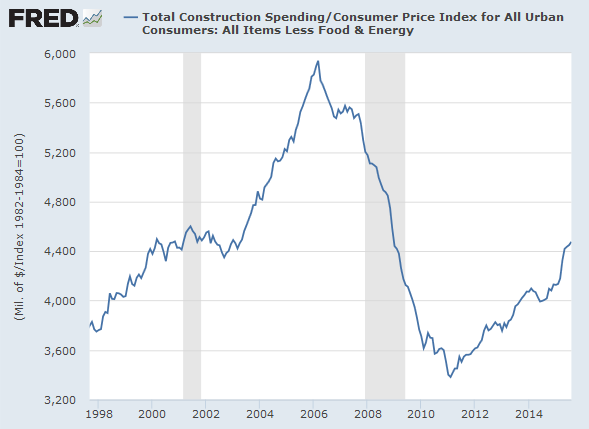
The S&P 500 is testing resistance at 2000. Bullish divergence on 21-day Twiggs Money Flow indicates (medium-term) buying pressure. Recovery above 2000 would signal a relieving rally, with a target (from the double-bottom pattern) of 2130*. The market remains bearish and respect of 2130 would warn of another test of primary support at 1870.
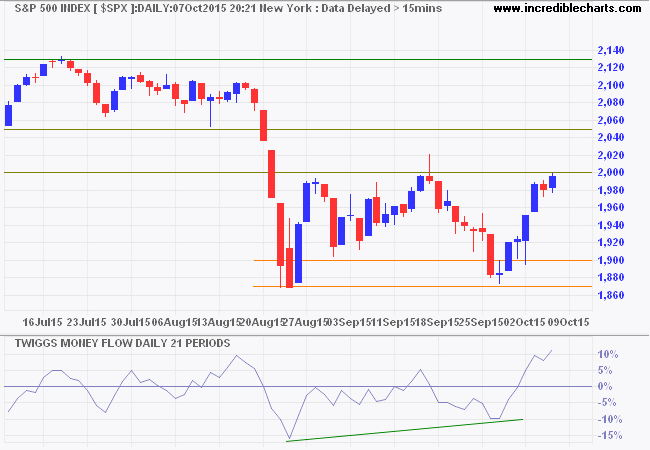
* Target calculation: 2000 + ( 2000 - 1870 ) = 2130
The CBOE Volatility Index (VIX) below 20 indicates market risk is easing. We need to remain vigilant for the next few weeks as VIX can be prone to false breaks.
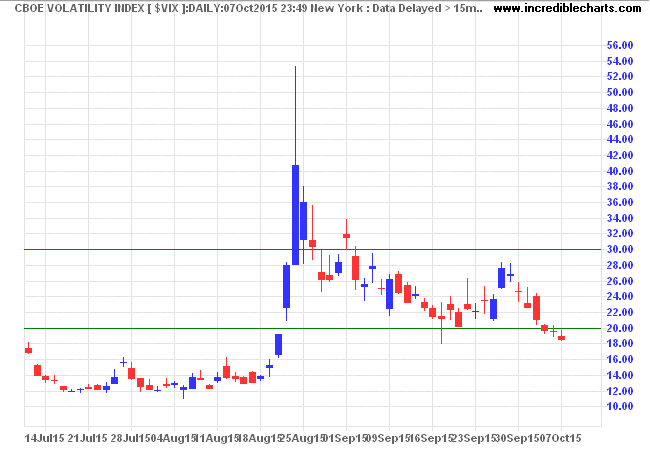
NYSE short sales are subdued.
Dow Jones Industrial Average is similarly testing resistance at 17000 on the weekly chart. Breakout would offer a similar target of 18300. Recovery of 13-week Twiggs Money Flow above zero indicates buying pressure. Reversal below 16000 is unlikely, but would confirm a primary down-trend.
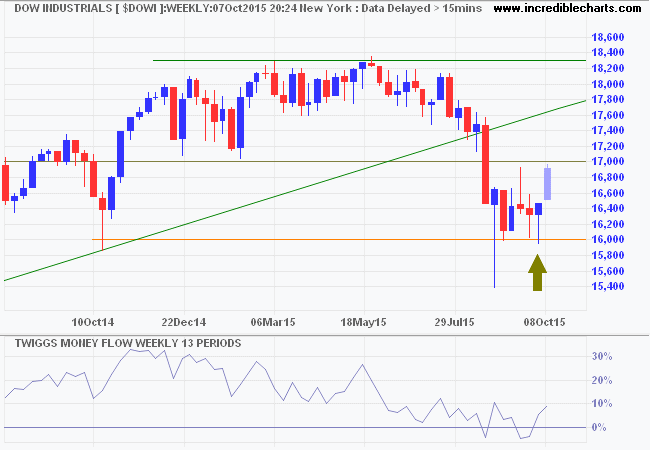
Canada's TSX 60 recovered above the former primary support level at 800. Follow-through above 820 would signal a relieving rally. Weak 13-week Twiggs Momentum, below zero, warns the market is still bearish.
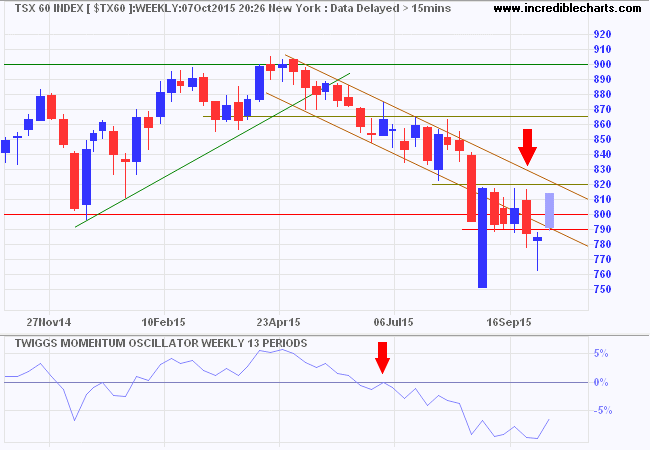
* Target calculation: 820 + ( 820 - 750 ) = 890
Europe
Germany's DAX remains weak, with 13-week Twiggs Money Flow below zero. Recovery above 10500 would indicate a bear rally. Only follow-through above 11000 would signal that the down-trend is over.
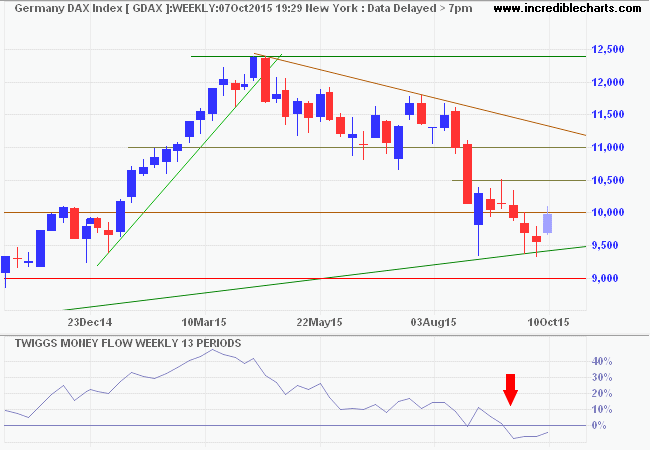
The Footsie proved more resilient, respecting support at 6000 with 13-week Twiggs Money Flow holding above zero. Breakout above 6300 indicates a relieving rally, while follow-through above the descending trendline would suggest that the correction is over. Reversal below 6000 is unlikely, but would confirm the primary down-trend.
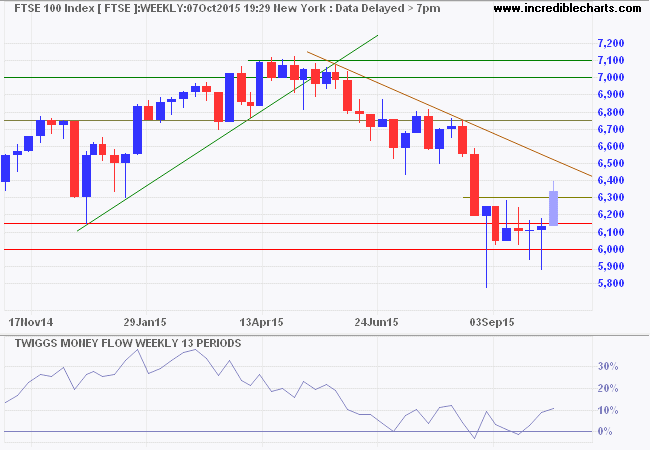
Asia
The Shanghai Composite Index continues to test government-enforced support at 3000. Recovery above 3500 is most unlikely.
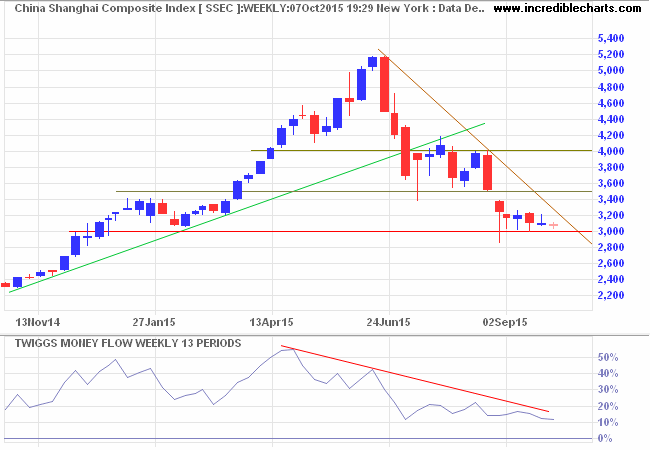
Hong Kong's Hang Seng Index rallied to test resistance at 22500, while 13-week Twiggs Money Flow recovered above zero. Follow-through above 22500 would indicate another test of 24000. But this remains a bear market and reversal below 22500 would warn of another decline.
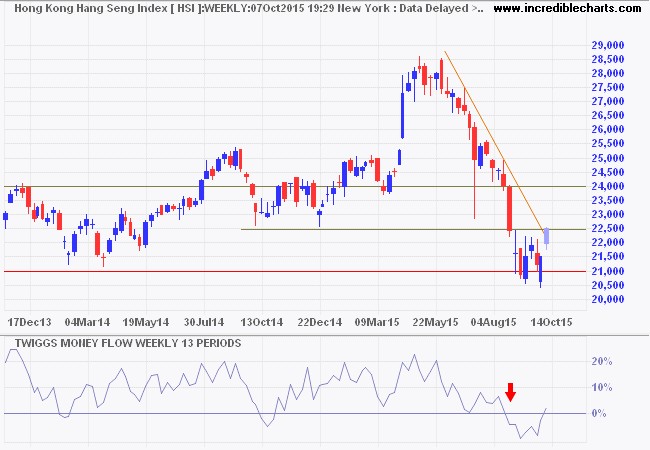
Japan's Nikkei 225 respected primary support at 17000. Gradual decline on 13-week Twiggs Money Flow suggests a secondary correction. Recovery above 19000 would indicate another test of 21000.
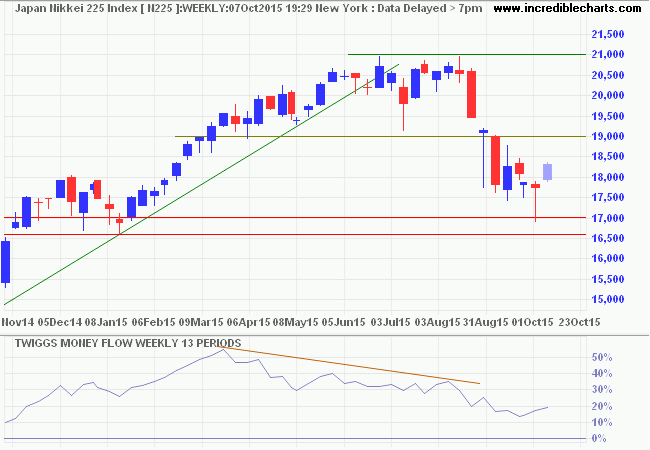
* Target calculation: 19000 + ( 19000 - 17000 ) = 21000
India's Sensex followed through above resistance at 26500, indicating a bear rally. Strong buying pressure, signaled by a 13-week Twiggs Money Flow trough above zero, suggests a reversal. Breakout above 28500 would confirm. Reversal below 25000 is unlikely, but would confirm a primary down-trend.
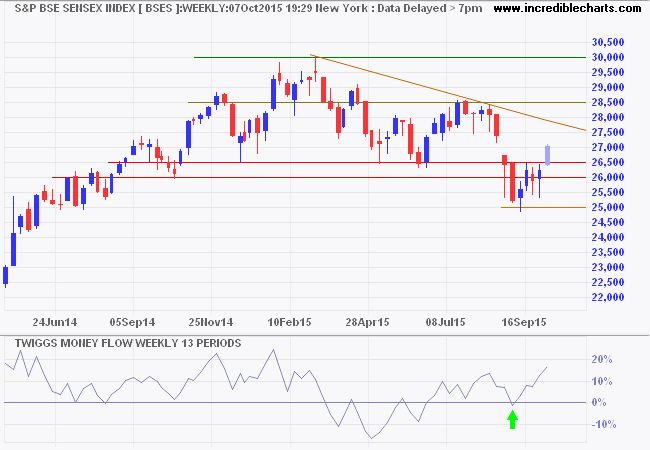
Australia
A monthly chart of the ASX 200 shows the significance of the 5000 support level.
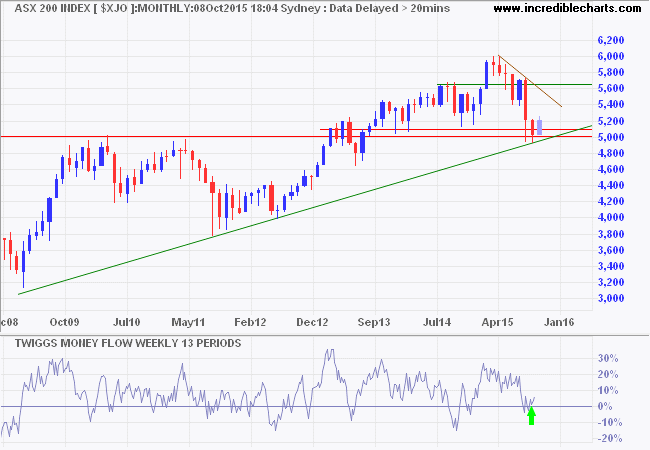
Rising 21-Day Twiggs Money Flow on the daily chart indicates medium-term buying pressure. Breakout above 5300 would offer a target of 5700. But expect stiff resistance between 5200 and 5300 — already flagged by a tall shadow on today's candlestick. Breach of 5000 is unlikely at present, but would confirm a primary down-trend.
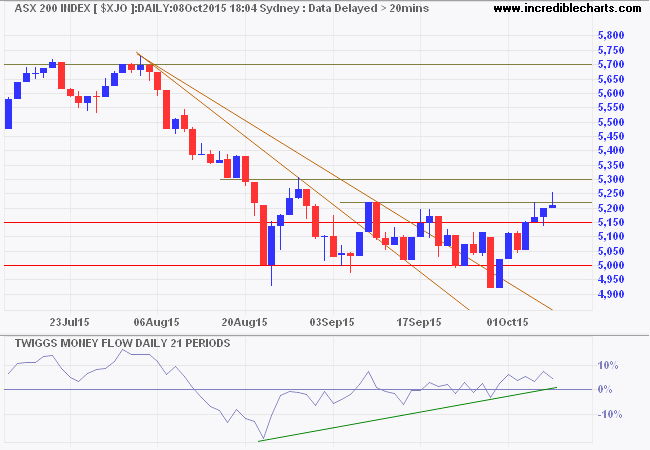
* Target calculation: 5000 - ( 5400 - 5000 ) = 4600
Deleveragings go on for about 15 years. The process of raising debt relative to incomes goes on for 30 or 40 years, typically. There's a last big surge, which we had in the two years from 2005 to 2007 and from 1927 to 1929, and in Japan from 1988 to 1990, when the pace becomes manic. That's the classic bubble. And then it takes about 15 years to adjust.
~ Ray Dalio, Bridgewater Associates
Disclaimer
Research & Investment Pty Ltd is a Corporate Authorized Representative (AR Number 384 397) of Andika Pty Ltd which holds an Australian Financial Services Licence (AFSL 297069).
The information on this web site and in the newsletters is general in nature and does not consider your personal circumstances. Please contact your professional financial adviser for advice tailored to your needs.
Research & Investment Pty Ltd ("R&I") has made every effort to ensure the reliability of the views and recommendations expressed in the reports published on its websites and newsletters. Our research is based upon information known to us or which was obtained from sources which we believe to be reliable and accurate.
No guarantee as to the capital value of investments, nor future returns are made by R&I. Neither R&I nor its employees make any representation, warranty or guarantee that the information provided is complete, accurate, current or reliable.
You are under no obligation to use these services and should always compare financial services/products to find one which best meets your personal objectives, financial situation or needs.
To the extent permitted by law, R&I and its employees, agents and authorised representatives exclude all liability for any loss or damage (including indirect, special or consequential loss or damage) arising from the use of, or reliance on, any information. If the law prohibits the exclusion of such liability, such liability shall be limited, to the extent permitted by law, to the resupply of the said information or the cost of the said resupply.
Important Warning About Simulated Results
Research & Investment (R&I) specialise in developing, testing and researching investment strategies and systems. Within the R&I web site and newsletters, you will find information about investment strategies and their performance. It is important that you understand that results from R&I research are simulated and not actual results.
No representation is made that any investor will or is likely to achieve profits or losses similar to those shown.
Simulated performance results are generally prepared with the benefit of hindsight and do not involve financial risk. No modeling can completely account for the impact of financial risk in actual investment. Account size, brokerage and slippage may also diverge from simulated results. Numerous other factors related to the markets in general or to the implementation of any specific investment system cannot be fully accounted for in the preparation of simulated performance results and may adversely affect actual investment results.
To the extent permitted by law, R&I and its employees, agents and authorised representatives exclude all liability for any loss or damage (including indirect, special or consequential loss or damage) arising from the use of, or reliance on, any information offered by R&I whether or not caused by any negligent act or omission.

Author: Colin Twiggs is a former investment banker with almost 40 years of experience in financial markets. He co-founded Incredible Charts and writes the popular Trading Diary and Patient Investor newsletters.
Using a top-down approach, Colin identifies key macro trends in the global economy before evaluating selected opportunities using a combination of fundamental and technical analysis.
Focusing on interest rates and financial market liquidity as primary drivers of the economic cycle, he warned of the 2008/2009 and 2020 bear markets well ahead of actual events.
He founded PVT Capital (AFSL No. 546090) in May 2023, which offers investment strategy and advice to wholesale clients.
